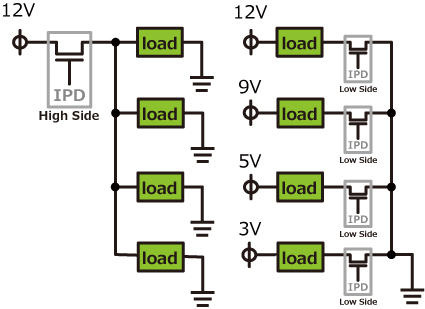High Side and Low Side Switches
High Side/Low Side Drive
A semiconductor switch placed in the upper circuit with respect to an external load is referred to as high-side drive (power supply side), and when mounted in the lower circuit is called low side drive (ground side).

[High Side Drive / Low Side Drive]
Usage examples for high side and low side switches
IPDs incorporate a high side switch for the upper circuit and a low side switch for the lower circuit with respect to external loads,
utilizing a circuit design optimized for each location.
As shown in the figure at left below,
in a circuit where various loads are connected to a single power supply voltage,
such as in a vehicle where the battery voltage is fixed and body connected to ground,
the output can easily become grounded,
making a high-side switch more suitable for detecting abnormal conditions such as ground faults.
Conversely,
low side switches are ideal for circuits in which loads are placed at various power supply voltages as shown in the figure at right below. The low side switch operates by applying an input voltage to the gate and connecting the MOSFET Source to ground. This control scheme is the same as with single MOSFETs,
making it easy to replace individual MOSFETs.

[High Side / Low Side Usage Examples]




